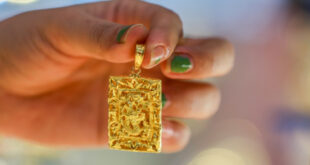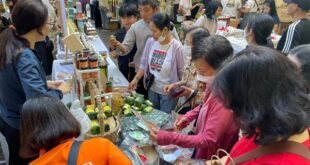People from all over Vietnam love different kinds of cha (sausage), and here’s several reasons why.
Cha lua – Steamed pork roll
Cha lua is also known as gio lua in the north. It is an essential dish served during the Tet holiday and other important occasions, including weddings, death anniversaries and almost any family parties.
To make cha lua, fresh, lean pork is pounded until it is pasty. Two or three teaspoons of fish sauce is added to the mixture before being wrapped in banana leaves. The pork rolls are then submerged into a pot of boiling water and boiled for about an hour.
 |
|
You can enhance the flavor of cha lua with a cup of chilli fish sauce. Photo by Luu Oanh |
Once it is cooked, cha lua has an ivory color with a slight pink undertone and a few tiny surface dents. It is savory and has the distinctive scent of infused banana leaves. Several meals may be made from a single roll of cha lua. During the Tet holiday, the dish is most commonly served at the dinner table alongside sticky rice cake banh chung. Cha lua also goes well with steamed rice rolls banh cuon, sticky rice cake banh day, and banh mi. Or it can simply be served with rice as a daily meal for Vietnamese families.
Cha chien – Fried pork roll
If you ever come to a cold cuts shop, you can easily find cha chien (fried pork roll) being sold along with its well-known sibling cha lua.
The fried roll uses a blend of lean pork and fat to provide a softer texture than cha lua, which exclusively uses lean meat as its primary component. The meat is mixed with fish sauce, potato starch, and pressed into a smooth paste. This mixture is then either steamed or wrapped in banana leaves and boiled in water. Here is where the cha chien most differs from its sibling: The pork roll is then deep-fried till golden brown.
 |
|
Cha chien simmered with pepper is a great home cooked meal. Photo by VnExpress |
The finished product has a stunning golden crust outside and a faintly yellow inside. It is softer and has a fattier, saltier flavor than cha lua because of the addition of pork fat. This delicacy, which tastes best when it is freshly fried, can be found as part of many well-known Vietnamese dishes, including sticky rice and banh mi. It’s also often used as a tasty side to many cozy home-cooked delicacies.
Cha com – Green rice patties
Com (green rice flakes) is a regional specialty often associated with autumn in Hanoi.
One recipe calls for com, lean pork, and pork paste. Salt, spices, and fish sauce are added to the mixture, which is then formed into little patites and steamed for around 20 minutes. The patties are then deep-fried until they are golden brown on both sides.
 |
|
Cha com is deep-fried till it turns golden. Photo by VnExpress |
After being fried, the green rice patties have a crisp crust, and a unique fragrance. Because of the usage of green rice flakes, the patties within are still soft and slightly chewy. This dish is best served hot with rice or rice noodles. One of the greatest ways to enjoy these scrumptious patties is as part of the traditional Hanoian meal known as bun dau mam tom (vermicelli with fried tofu and shrimp paste).
Cha muc – Fried squid paste
This paste originates from Ha Long, the capital city of Quang Ninh province, one of Vietnam’s largest popular seafood regions. Fried squid paste is a delicious dish that attracts both local residents in Ha Long and tourists.
Cha muc is made of large squids that weigh between 1.5 and 2 kilos each and are harvested every day from the sea. The squid meat is hand-pounded before being spiced with a combination of pepper, onion, and garlic. To intensify the sweet flavor, some eateries even add pig fat or peeled shrimp to the mixture. After that, more chopped tentacle pieces are added to give the fried paste its crunch. The paste is separated and formed into flat and round pieces before being deep fried in hot oil.
 |
|
Freshly fried cha muc tastes the best when eaten with hot rice. Photo by VnExpress |
The thick and crispy squid flesh adds a unique texture to the meal. Fried squid paste has an inviting scent, a strong umami flavor, and is a little greasy but in a good way. Cha muc is frequently served with steamed rice rolls or hot rice. The meal tastes best the way locals eat it: right away, hot off the pan.
Lap xuong – Chinese style sausage
Lap xuong, sometimes referred to as Lap Cheong (or Chinese style sausage), is a traditional dish traditionally served across southern Vietnam during Tet celebrations. But it has now become so well-liked that it is consumed all year round in many parts of the nation. It is also a favorite ingredient for many other Vietnamese dishes.
The sausage is made from small pig intestine, pork fat, lean pork, Mai Que Lo wine – a rose-flavored sorghum liquor – and spices including sugar, salt, dry black pepper. Lean pork and pork fat are cut into small cubes and combined with seasonings. The intestines are then stuffed with the mixture. The cook will separate the intestines into several parts using threads to make chunks of sausages. The stuffed intestines are then sun-dried for one to five days, depending on the weather.
 |
|
Lap xuong becomes dull-red once dried. Photo by VnExpress/Ngoc Thanh |
When the sausages are eventually dried, they become shiny and medium firm. The fat becomes more transparent and less greasy. The delicacy has a lovely reddish-pink hue and a sweet-salty flavor. Lap xuong can be preserved for a few days to many months. The sausage may be cooked in a variety of ways, including grilling, frying, and steaming. When cooked, the sausages become more soft, less oily, and incredibly aromatic compared to raw ones. You can find the sausage in many delicious Vietnamese dishes such as sticky rice, rice paper rolls, and savory mooncakes.
Gio thu – Head cheese
Gio thu, known as head cheese, is not a cheese at all, but a cold cut dish produced from a pig’s head. The dish originated in northern Vietnam. This dish is a gelatinous meaty mixture formed from the various sections of the head of a pig, which means thu in Chinese Vietnamese. Gio thu is often served as a part of a charcuterie during the Tet holiday, to be dipped in fish sauce and chili peppers.
 |
|
Gio thu is a cold cut dish that often appears during the Tet holiday. Photo by Luu Oanh |
The dish is created from almost any part of a pig’s head, including the ears, nose, cheek, and tongue. The meat is combined with black mushrooms, fish sauce, garlic and shallots, and black peppercorns. To make the gelatinous meat, all of the components are boiled and simmered together. After that, the meat is wrapped in banana leaves and compressed in a mold. When the meat cools, it becomes crispy and delicious. It has a marble texture, is chewy and meaty, and has a strong flavor from all spices. This dish can be enjoyed cold and pairs well with pickles.
Cha ca – Fried fish cake
Cha ca is a popular food in Vietnamese households due to its versatility. To obtain a bouncy and chewy texture, fried fish cakes can only be made with specific fish, such as mackerel. Typically, the mackerel meat is mashed into a paste before being seasoned with fish sauce, salt, sugar, and ground black pepper. The paste is formed into patties, which are then fried until golden.
 |
|
Cha ca noodles are served with greens and chilli fish sauce. Photo by VnExpress |
The fried fish cake has a chewy texture, with a signature kick from the addition of black pepper. It is savory and slightly fishy. Cha ca should be eaten when it is still hot so that you can enjoy all of the delightful aroma. The fish cake can be eaten with rice, on a roll, in noodle soup or just on its own. Many street stalls in Saigon serve banh mi with fried fish cakes. You can watch them fried the fish cakes at most streetside banh mi joints.
Cha trung – Egg meatloaf
If you’ve already tried regular meatloaf, then try cha trung, also known as egg meatloaf. It’s a common pork and egg dish in Saigon. Steamed egg meatloaf is made of egg, ground pork, green onions, and wood ear mushrooms. Before steaming or baking, egg yolk is spread on top of the meatloaf to give it a yellow color when served. Anyone can prepare this dish at home because it is so simple.
 |
|
A triangle piece of cha trung sits on top a plate of com tam. Photo by VnExpress |
Cha trung is not one of the most visually appealing foods, but it tastes incredible. It has a marble-like appearance, spongy and light texture, as well as a deep umami and eggy flavor. The food is cut into slices and can be enjoyed either warm or at room temperature. It is typically eaten with rice.
Cha ruoi – Ragworm omelet
As the weather in Hanoi becomes cool in the late fall and early winter, it’s common to find the unusual cuisine cha ruoi. The dish is prepared using eggs and ragworms, also known as palolo worms, which are a type of sea worm harvested in northern regions. Although the worms alone may be unsettling to some foreigners, when they are added to an omelet, they make a delectable dish that is sometimes overlooked.
 |
|
Cha ruoi is wrapped in fresh leaves. Photo by VnExpress/Khanh Tran |
Ragworms are blanched in boiling water to remove their tentacles before being combined with minced pork, tangerine peels, herbs, and eggs. The mixture is then fried in hot oil. Cha ruoi has a fatty and oily flavor, is sweet enough, and is slightly crunchy. It has a pleasant aroma of tangerine and spices. The dish is often served hot with noodles, veggies, and sweet and sour fish sauce.
- Reduce Hair Loss with PURA D’OR Gold Label Shampoo
- Castor Oil Has Made a “Huge” Difference With Hair and Brow Growth
- Excessive hair loss in men: Signs of illness that cannot be subjective
- Dịch Vụ SEO Website ở Los Angeles, CA: đưa trang web doanh nghiệp bạn lên top Google
- Nails Salon Sierra Madre
 VnExpress News The News Gateway of Vietnam
VnExpress News The News Gateway of Vietnam




